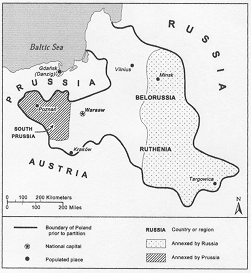Displaying image 99 of 467 images in History.
The Second Partiton. Solid line: Poland's borders in 1793, prior to Partition. Shaded areas: areas lost as a result of the Paritition.
Destruction of Poland-Lithuania
Passage of the constitution alarmed nobles who would lose considerable stature under the new order. In autocratic states such as Russia, the democratic ideals of the constitution also threatened the existing order, and the prospect of Polish recovery threatened to end domination of Polish affairs by its neighbors. In 1792 domestic and foreign reactionaries combined to end the democratization process. Polish conservative factions formed the Confederation of Targowica and appealed for Russian assistance in restoring the status quo. Catherine gladly used this opportunity; enlisting Prussian support, she invaded Poland under the pretext of defending Poland's ancient liberties. The irresolute Stanislaw August capitulated, defecting to the Targowica faction. Arguing that Poland had fallen prey to the radical Jacobinism (see Glossary) then at high tide in France, Russia and Prussia abrogated the Constitution of May 3, carried out a second partition of Poland in 1793, and placed the remainder of the country under occupation by Russian troops.
The second partition was far more injurious than the first. Russia received a vast area of eastern Poland, extending southward from its gains in the first partition nearly to the Black Sea. To the west, Prussia received an area known as South Prussia, nearly twice the size of its first-partition gains along the Baltic, as well as the port of Gdansk (then renamed Danzig). Thus, Poland's neighbors reduced the commonwealth to a rump state and plainly signaled their designs to abolish it altogether at their convenience.



 Searching...
Searching...

 Previous
Previous
 Next
Next